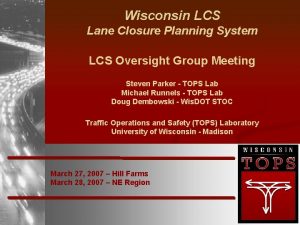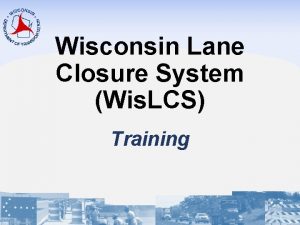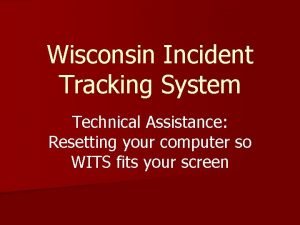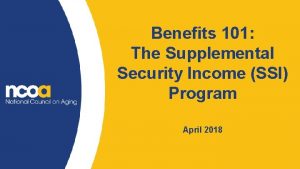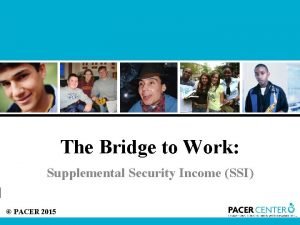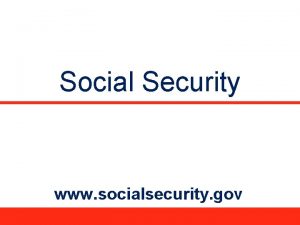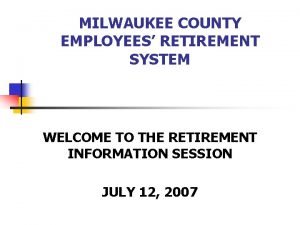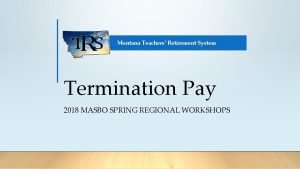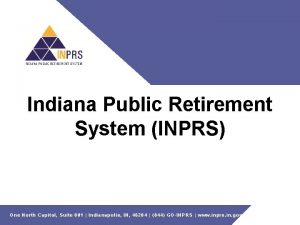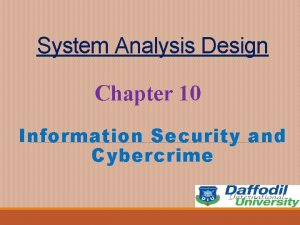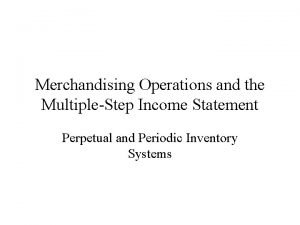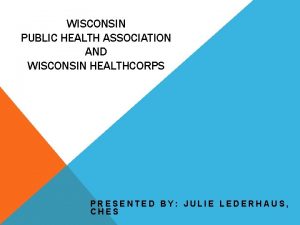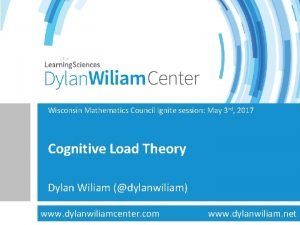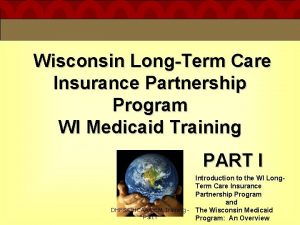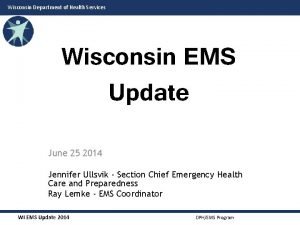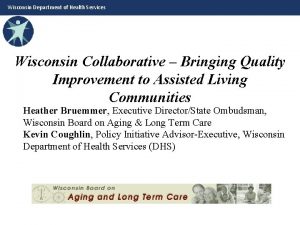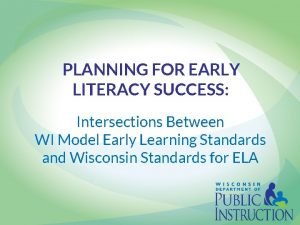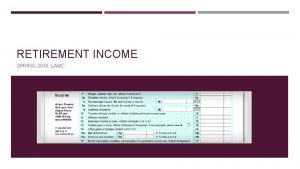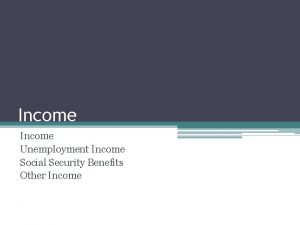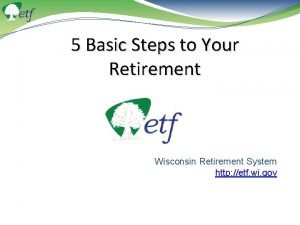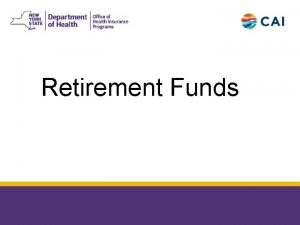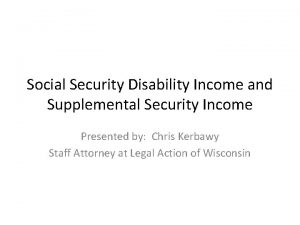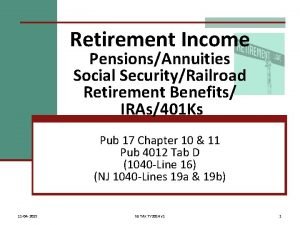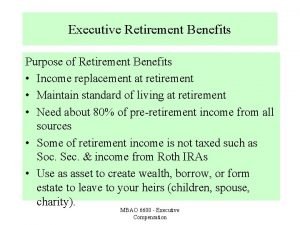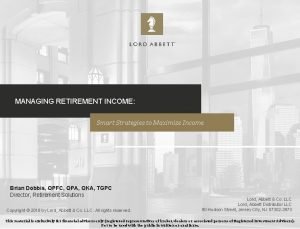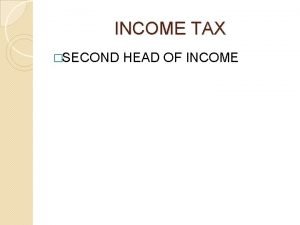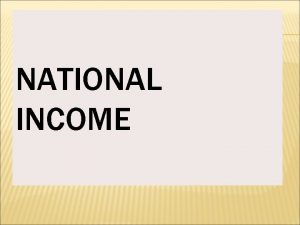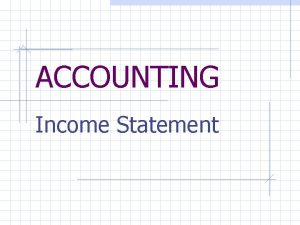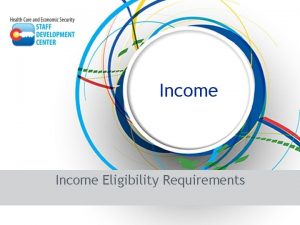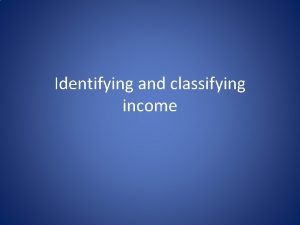The US Retirement Income System Wisconsin Retirement Security














































































- Slides: 78

The US Retirement Income System Wisconsin Retirement Security Task Force David C. John AARP Public Policy Institute October 25, 2019 AARP PUBLIC POLICY INSTITUTE | AARP. ORG/PPI | © 2018 AARP. ALL RIGHTS RESERVED

Wisconsin Retirement Security Task Force Our Current Retirement System AARP PUBLIC POLICY INSTITUTE | AARP. ORG/PPI | © 2018 AARP. ALL RIGHTS RESERVED Page 2

Wisconsin Retirement Security Task Force Social Security is the bedrock • • Close to universal coverage OASI tax rate 5. 3% for both employer & employee (10. 6% for self-employed) Also disability coverage & Medicare (not discussed in this presentation) Taxes apply to first $132, 900 in 2019 Benefits based on top 35 years of adjusted lifetime income – taxable income only Benefits depend on when they are claimed between ages 62 and 70 Benefits are inflation indexed to changes in CPI 3 rd quarter to 3 rd quarter. Benefits paid through a trust fund AARP PUBLIC POLICY INSTITUTE | AARP. ORG/PPI | © 2018 AARP. ALL RIGHTS RESERVED Page 3

Wisconsin Retirement Security Task Force But the average benefit is too low for most • • • Average monthly benefit for new awards and for benefits in current-payment status (in dollars) Retired workers: New awards: $1, 523 a month, $xx, xxx per year Average for all including those already retired: $1, 461 a month, $xx, xxx per year Benefits are progressive: Traditional replacement rates are 90% for lowest earners, @42% for average income workers (@$54, 000), @23% for highest income • Couples can get 150% or own benefits. At death, survivor get highest. • SOURCE: SSA, Master Beneficiary Record, 100 percent data. AARP PUBLIC POLICY INSTITUTE | AARP. ORG/PPI | © 2018 AARP. ALL RIGHTS RESERVED Page 4

Wisconsin Retirement Security Task Force There is no easy fix for Social Security • Long-term demographic trends mean longer times in retirement. – Longevity at age 65 is the key measurement, not at birth • Increasing benefits is possible, but needs revenue & could change nature of the system • Reducing benefits is unpopular & has serious effects on retirement income of those affected • Raising retirement age is difficult politically & may not solve the problem • Increasing taxes is unpopular & has labor market effects • Means testing is unpopular & difficult to administer AARP PUBLIC POLICY INSTITUTE | AARP. ORG/PPI | © 2018 AARP. ALL RIGHTS RESERVED Page 5

Wisconsin Retirement Security Task Force Employer-Based Plans: Defined Benefit • • Widespread use dates to World War II – voluntary for employers Mostly offered through single employer Paid as a regular source of income In most cases, costs paid by employer, who assumed all risk Usually financed through an investment pool Benefit based on a formula such as 3% of average of last three years income x years of service Until recently, vesting requirements varied widely; many did not receive benefits • Also multi-employer “Taft-Hartley” plans that cover industries through labor agreements. AARP PUBLIC POLICY INSTITUTE | AARP. ORG/PPI | © 2018 AARP. ALL RIGHTS RESERVED Page 6

Wisconsin Retirement Security Task Force Private DB Plans: What Happened? • • • Demographics Returns on investments Funding issues “Derisking” Cashing in benefits • PBGC insurance, important, but limited to $65, 045 at 65, but only $29, 270 at 55 – Multi: 20 years of service, the current annual limit is 100% of the first $2, 640 and 75% of the next $7, 920 for a total guarantee of $8, 580 per year. AARP PUBLIC POLICY INSTITUTE | AARP. ORG/PPI | © 2018 AARP. ALL RIGHTS RESERVED Page 7

Wisconsin Retirement Security Task Force Employer-Based plans: Defined Contribution • • • Retirement savings plans that may or may not have an employer match Like a DB, voluntary for employers Developed accidently, not a planned system Various names & types, but IRA & 401(k) serve as examples All risk borne by employees • Typically payroll deduction, may be auto or not • Can be traditional (tax deferred) or Roth (after tax contributions) • Mainly found in larger employers AARP PUBLIC POLICY INSTITUTE | AARP. ORG/PPI | © 2018 AARP. ALL RIGHTS RESERVED Page 8

Wisconsin Retirement Security Task Force 401(k), MEPs, Payroll Deduction IRA • Contribution limits in 2019: 401(k): $19, 000; IRA: $6, 000 – Additional catch up for those over 50 seldom used (401(k) +$6, 000, IRA +$1, 000) • Same limits for both traditional & Roth • 401(k) is an ERISA plan & has consumer protections – Subject to anti-discrimination testing – Voluntary for employers: most want to attract & keep good employees • MEPs don’t really exist yet, but will essentially be 401(k) plans for multiple companies • Payroll deduction IRAs mainly used by state programs & are not ERISA plans AARP PUBLIC POLICY INSTITUTE | AARP. ORG/PPI | © 2018 AARP. ALL RIGHTS RESERVED Page 9

Wisconsin Retirement Security Task Force Problems with DC plans • Only about half of US employees have a plan. About 55 million not covered. – 401(k) is expensive for smaller employees & many do not have one – Hourly earners & low income especially likely not to be covered – Most permanent part-time employees not covered • All risk on employees • Many cash out when leaving a job; other money used pre-retirement (up to 40% of contributions) • Rolling over money can be complex – IRAs may not be appropriate; other plans may not accept AARP PUBLIC POLICY INSTITUTE | AARP. ORG/PPI | © 2018 AARP. ALL RIGHTS RESERVED Page 10

Wisconsin Retirement Security Task Force Who is not covered? • Employees working for an employer without a plan by percent not covered: – Hispanic (65%), Asian (52%), Black (50%), White (43%) – Less than high school (74%), high school (55%), some college (49%), graduate (35%) – Under $14, 000 (75%), $14 k to $25 k (62%), $25 k to $40 k (44%), $40 k to $63. 5 k (34%), Over $63. 5 k (25%) – Under 10 employees (83%), 10 -49 (68%), 50 -99 (52%), 100 -500 (41%) AARP PUBLIC POLICY INSTITUTE | AARP. ORG/PPI | © 2018 AARP. ALL RIGHTS RESERVED Page 11

Wisconsin Retirement Security Task Force Cost of Poor Coverage • States & the federal government face higher benefit payments & other services • Fiscal Savings to States of $1, 000 More in Retirement Income for the Bottom Two Retirement Income Quintiles 2018 -2032: – Federal + state: $33 billion; state share: $7. 8 billion – Wisconsin: Federal + state: $684 million; state $139 million • Also lost purchasing power of retirees. In PA, that is estimated at $55 billion over 15 years which would reduce state tax collections by $1. 4 billion over that period. AARP PUBLIC POLICY INSTITUTE | AARP. ORG/PPI | © 2018 AARP. ALL RIGHTS RESERVED Page 12

Wisconsin Retirement Security Task Force Individual Savings: IRA • Available to all, but only tax deductible if no employer plan • Can be traditional or Roth – Roth has income limits ($122 k - $137 K single, $193 k - $203 k joint) • Most balances are due to rollovers from employer plans • Only 5 -10% of those with no other plan actually save regularly – Almost all of those are upper income AARP PUBLIC POLICY INSTITUTE | AARP. ORG/PPI | © 2018 AARP. ALL RIGHTS RESERVED Page 13

Wisconsin Retirement Security Task Force Savings Tools • Financial literacy – Important to include in schools – Works to a limited extent as just in time information – No real effect on retirement savings • Behavioral Finance – Defaults work & popular – Individual has control • State retirement saving program AARP PUBLIC POLICY INSTITUTE | AARP. ORG/PPI | © 2018 AARP. ALL RIGHTS RESERVED Page 14

Wisconsin Retirement Security Task Force Questions or suggestions? David John Senior Strategic Policy Advisor djohn@aarp. org AARP PUBLIC POLICY INSTITUTE | AARP. ORG/PPI | © 2018 AARP. ALL RIGHTS RESERVED Page 15

Wisconsin Retirement System Wisconsin Deferred Compensation Program An Overview Tarna Hunter Wisconsin Department of Employee Trust Funds Retirement Security Task Security Force –Task October 25, 2019 WRS Overview: Retirement Force Meeting – October 2019 16

Background Wisconsin Retirement System • Statewide, defined benefit plan • Some defined contribution features • Covers most public employees in Wisconsin • State, University, Elected, Judicial, Teachers, Municipal, Public Safety WRS Overview: Retirement Security Task Force Meeting – October 2019 17

Wisconsin Retirement System • Established 1982 • Merger of several smaller plans over 40 years Wisconsin Retirement Fund for State and Municipal Employees Milwaukee Teachers Retirement Fund State Teachers Retirement Fund WRS Overview: Retirement Security Task Force Meeting – October 2019 Wisconsin Retirement System 18

WRS Employers and Participants A 1500 27% State Public Employers 73% Local 639 K Participants WRS Overview: Retirement Security Task Force Meeting – October 2019 40% Active 33% Retired 27% Vested / Deferred 19

Well Funded 100% Funding Method 103% Market Value (Estimated) GASB, 12/31/17 WRS Overview: Retirement Security Task Force Meeting – October 2019 $108 Billion In Assets 3/31/19 8 th Largest public pension 20

WRS Key Risk-Sharing Features • Split normal cost contribution rates between employer and employee • Post-retirement benefit adjustments based on investment performance • Active employee money purchase benefit minimum/Variable Fund WRS Overview: Retirement Security Task Force Meeting – October 2019 21

Annual Rate Setting 1 Board establishes rates annually based upon recommendation of consulting actuary 2 Normal cost contribution rates are split evenly between employers and employees • 2020 Contribution Rates: 13. 5% ER: 6. 75% 3 EE: 6. 75% Contributions are remitted monthly • 2018 Statewide Payroll: $14. 3 B • WRS can intercept state aids for non-payment WRS Overview: Retirement Security Task Force Meeting – October 2019 22

Annuities and Contributions* Annuities are expected to continue to increase as a percent of payroll for several more decades. *Average total rate shown is for General Participants WRS Overview: Retirement Security Task Force Meeting – October 2019 23

Impact on Taxpayers 2. 1% on public pensions All other state and local govt spending • State and local governments in Wisconsin spend 2. 1% of their budgets on public pensions (WRS is largest) • National average: 4. 7% Fiscal Year 2016 Source: National Association of State Retirement Administrators (March 2019) WRS Overview: Retirement Security Task Force Meeting – October 2019 24

WRS Retirement Benefits ETF compare two calculations: Money Purchase • Account balance • Age Formula vs. • Years of service • 3 highest years of earnings • Category • Age WRS Overview: Retirement Security Task Force Meeting – October 2019 Members get paid the higher of the 2 25

WRS Core and Variable Funds Core Fund Core + Variable Fund • Automatic enrollment for all employees • Optional 50% of contribution • Diversified portfolio • All-stock portfolio • Guaranteed minimum annuity payment • No guaranteed minimum annuity payment • 5 -year smoothing • No smoothing WRS Overview: Retirement Security Task Force Meeting – October 2019 26

No Cost of Living Adjustment • Compounding adjustments are based on investment performance • A 5% investment return assumption is used to fund original retirement benefit • Only investment returns in excess of 5% can produce an increase in annuity • For example, 7. 0% performance - 5% = ~2% annuity adjustment • Can reduce previously granted adjustments • Average annual adjustment since 1982 merger • Core: 3. 7% • Variable: 3. 8% • In 2018 $5. 4 billion in benefits paid ! Between 2009 and 2013, pensions reduced by cumulative $6 billion WRS Overview: Retirement Security Task Force Meeting – October 2019 27

WRS Annuities by Amount in 2018 WRS Overview: Retirement Security Task Force Meeting – October 2019 28

Economic Impact WRS Overview: Retirement Security Task Force Meeting – October 2019 29

WRS: Strong for Wisconsin • “For those seeking out well-funded public pension plans, it's time to go north – northwards from Illinois, that is, to the greener pastures of the Wisconsin Retirement System. Wisconsin's public pension system, unique among not just public pensions but among any defined benefit pension in the United States, is designed to share risks. There is no better place than to start with the Wisconsin Retirement System. ” - Forbes, March 2019 WRS Overview: Retirement Security Task Force Meeting – October 2019 30

Wisconsin Deferred Compensation Program • 1978: Federal legislation established Internal Revenue Code Section 457 deferred compensation plans for state and local governments. • 1982: WDC was established • Oversight by ETF Board • No State funds for administration • Created WDC Board WRS Overview: Retirement Security Task Force Meeting – October 2019 31

WDC Board • 5 members appointed by the Governor and confirmed by the State Senate serve 4 year staggered terms. Has one advisory-only committee: Investment Committee. • 2 - 3 meetings per year. • Statutory responsibility to provide policy direction and program oversight including setting participant fees, approving contracts for administrative services and audits, and hearing participant appeals. • Selects and monitors investment fund options. • Maintains Plan and Trust document. • Develops and follows formal Investment Policy Statement. WRS Overview: Retirement Security Task Force Meeting – October 2019 32

WDC Basics • Voluntary savings plan for public employees. • Before-tax and/or Roth contributions. • Payroll deduction by dollar amount or percent. • No minimum contribution required. • Portable among qualified retirement plans. • Can use to purchase WRS forfeited and qualifying service. • Plan Assets: $4. 7 Billion • Contributions: $234. 4 Million • Employers: 933 (State of WI and 932 Local Government Employers) • Participants: 66, 153 (38, 556 State and 27, 597 Local) WRS Overview: Retirement Security Task Force Meeting – October 2019 33

WDC Costs for Participants (no employer costs) • WDC participant administrative fees: Account Balance Monthly Fee Annual Fees $1 -$5, 000 $0 $0 $5, 001 – $25, 000 $1 $12 $25, 001 – $50, 000 $3 $36 $50, 001 – $100, 000 $6 $72 $100, 001 – $150, 000 $8 $96 $150, 001 - $250, 000 $11 $132 Over $250, 000 $16. 50 $198 • Additional services and fees – optional advisory services • Individual investment option operating expenses WRS Overview: Retirement Security Task Force Meeting – October 2019 34

WDC Assets and Participation As of December 31, 2018 Plan Assets (thousands) Participants $5, 000 70, 000 $4, 500, 000 60, 000 $4, 000 50, 000 $3, 500, 000 $3, 000 40, 000 $2, 500, 000 30, 000 $2, 000 $1, 500, 000 20, 000 $1, 000 10, 000 $500, 000 7 9 8 1 8 9 8 1 9 9 9 1 0 9 9 1 1 9 9 1 2 9 9 1 3 9 9 1 4 9 9 1 5 9 9 1 6 9 9 1 7 9 9 1 8 9 9 2 9 0 0 2 0 0 0 2 1 0 0 2 2 0 0 2 3 0 0 2 4 0 0 2 5 0 0 2 6 0 0 2 7 0 0 2 8 0 0 2 9 0 1 2 0 0 1 2 1 0 1 2 2 0 1 2 3 0 1 2 4 0 1 2 5 0 1 2 6 0 1 2 7 0 1 8 1 6 8 1 9 8 8 9 9 1 1 5 0 4 $0 Assets WRS Overview: Retirement Security Task Force Meeting – October 2019 Participants 35

2018 WDC Enrollments by Participant Age 1, 600 Enrollments 1, 400 1, 200 1, 000 800 600 400 200 0 up to 26 26 -33 34 -48 WRS Overview: Retirement Security Task Force Meeting – October 2019 49 -55 56 -62 63 and up 36

WDC Participation WRS Overview: Retirement Security Task Force Meeting – October 2019 37

WDC Contributions WRS Overview: Retirement Security Task Force Meeting – October 2019 38

WDC Average Account Balance WRS Overview: Retirement Security Task Force Meeting – October 2019 39

WDC Benefit Payment History WRS Overview: Retirement Security Task Force Meeting – October 2019 40

WDC Participant Services • 11 local field staff - on site service to employers and participants in Wisconsin • Retirement readiness reviews • WDC website: www. wdc 457. org with 24/7 online account access via PIN login • Quarterly account statements • Milwaukee-based call center: Monday through Friday from 7 am to 9 pm and Saturdays from 8 am to 4: 30 pm. (877) 457 -WDCP (9327) WRS Overview: Retirement Security Task Force Meeting – October 2019 41

Thank you etf_wi etf. wi. gov ETF 2019 E-mail WRS Overview: Retirement Security Task Force Meeting – October Updates 608 -266 -3285 42 1 -877 -533 -5020

Retirement Security in Wisconsin Legislative Reference Bureau Jessie Gibbons, legislative analyst Mary Alice Mc. Greevy, legislative attorney October 2019

Overview 1. 2. 3. 4. 5. Major retirement expenses Elder poverty in Wisconsin Costs and potential savings in Wisconsin’s aging population Income in retirement a) b) c) d) Social Security Defined benefit plans Defined contribution plans Personal savings

1. Major Retirement Expenses

Retirement Expenses • Retirement savings goal: • Save 8 -12 times annual income • Replace 85% of prior income in retirement • Retirees spend less on: • Child care • Groceries • Transportation • Travel & entertainment • Retirees spend more on: • Housing • Health care

Housing Expenses • 80% of retirees own their homes • Property taxes • Heating and cooling costs • Repairs • Many rent housing or move to retirement communities, assisted living facilities, or long-term care facilities

Long-Term Care Costs • 70% of 65 -year-olds will require long-term care services • Average male requires them for 2. 2 years • Average female requires them for 3. 7 years • 20% will need them for 5 or more years Type of care Annual cost in WI (2019) Home health aide $57, 204 Adult day health care $18, 720 Assisted living facility $52, 200 Nursing home care (semi-private room) $99, 276 Nursing home care (private room) $112, 788 Source: Genworth, “Cost of Care Survey 2019”

Health Care Costs • Gaps in Medicare coverage: long-term care, vision, dental, hearing care, assistive technologies • Out-of-pocket costs: Medicare premiums, deductibles, coinsurances, copayments, supplemental Medigap coverage • 1 in 10 Medicare beneficiaries spends 75% of retirement income on out-of-pocket health care costs

Median Share of Income Spent by Medicare Beneficiaries on Health Care, by Sex and Race/Ethnicity All Beneficiaries 17. 2% Men 15. 2% Women 19. 0% White 17. 8% Black 15. 5% Hispanic 12. 2% Other 13. 1% Source: AARP Public Policy Institute, “Medicare Beneficiaries Out-of-Pocket Spending for Health Care”

Out-of-Pocket Medicare Costs Service Percentage of beneficiaries using service Average amount spent per year Hospital inpatient care 17. 8 $533 Hospital outpatient care 75. 7 $196 Medical providers 96. 7 $744 Prescription drugs 91. 3 $618 Home health 19. 1 $626 Skilled nursing facility 5. 8 $2, 118 Dental care 47. 0 $665 Long-term care facility 6. 0 $16, 737 Source: AARP Public Policy Institute, “Medicare Beneficiaries Out-of-Pocket Spending for Health Care”

2. Elder Poverty in Wisconsin

Percentage of Elderly Wisconsinites in Poverty, 2008 -2017 12 10. 4 9. 6 10 10 9. 8 9 8. 6 8 8. 3 7. 4 9. 5 7. 8 6 4 2 0 2008 2009 2010 2011 2012 2013 2014 2015 2016 Source: Institute for Research on Poverty, “Wisconsin Poverty Report, June 2019” 2017

Percentage of Population in Poverty, by Age and Sex, 2016 16 13. 4 14 11. 6 12 9. 6 10 8 10. 7 8. 2 7. 6 7. 3 7. 4 6 4 2 0 65 -74 75 -84 85 and Older Male 65 and Older Female Source: United States Census Bureau, “The Population 65 Years and Older in the United States: 2016”

Percentage of Population in Poverty, by Age and Race/Ethnicity, 2016 25 20. 5 19. 3 20 17. 2 18. 7 18. 1 16. 9 15. 6 15 13. 7 18. 7 16. 3 15. 6 15 18. 1 14. 7 12. 9 11 9. 7 10 7. 8 6. 4 7. 2 5 0 65 -74 75 -84 Hispanic 85 and Older Black Asian White 65 and Older Other Source: United States Census Bureau, “The Population 65 Years and Older in the United States: 2016”

Factors Contributing to Elder Poverty • Health care expenses rise with age • Declining health • Difficultly living independently • Purchasing power of income decreases with age • Social Security cost-of-living adjustments • Other minor benefit adjustments

3. Costs and Potential Savings in Wisconsin

Wisconsin Benefit Programs • Elders living in poverty are more likely to require the services provided by state-administered benefit programs, including: • • Medicaid Elderly Nutrition Program Senior. Care Prescription Drug Assistance Program Specified Low Income Medicare Beneficiary Program Qualified Medicare Beneficiary Program Supplemental Security Income Wisconsin Home Energy Assistance Program

Cost of Elder Poverty in Wisconsin Program 2014 Enrollment 2018 Enrollment 2014 Expenditures Medicaid (elderly enrollees only) 2018 Expenditures 61, 621 66, 178 $1. 8 billion $1. 9 billion ($27, 962 per enrollee) Medicare Cost Sharing Assistance 21, 980 23, 297 Not available $331. 4 million Senior. Care 85, 740 92, 371 $90. 7 million $105. 3 million Supplemental Security Income (SSI) (elderly enrollees only) 6, 901 6, 778 $183 million $181 million Source: Wisconsin Legislative Fiscal Bureau, “January 2019 Informational Papers”

Potential Savings • A 2017 study by the La Follette School of Public Affairs found that state expenditures in 2030 could be $3. 1 billion lower than currently projected if workers aged 50 -54 making $40, 000 or less saved 5% annually. • A 2017 study by the AARP found that state expenditures by 2032 would be $139 million less if the income of lower-income retirees increased by $1, 000 more per year. • A 2017 study by Segal Consulting found that state expenditures over 10 years would be $96. 4 million less after the introduction of a statewide retirement savings program.

4. Wisconsin’s Aging Population

Wisconsin’s Aging Population • At 65, Wisconsin males can expect another 18. 7 years, and females can expect another 21. 3 years • The average in Wisconsin is 39. 2 • The average nationally is 37. 8 • 17% of Wisconsin’s population is over age 65 • 15. 9% of Minnesota’s population is over 65 • 15. 6% of Illinois’ population is over 65 • 16% is the national average

Wisconsin Counties with the Longest and Shortest Life Expectancies, 2010 -2014 Shortest Life Expectancies Longest Life Expectancies Menominee 72. 5 Kewaunee 82. 0 Washburn 76. 7 Ozaukee 81. 8 Sawyer 77. 1 Pierce 81. 6 Ashland 77. 5 Waukesha 81. 5 Milwaukee 77. 6 Taylor 81. 5 Source: Wisconsin Department of Health and Human Services, “Life Expectancy in Wisconsin: 2010 -2014”

Life Expectancy in Wisconsin by Race/Ethnicity, 2010 -2014 92 87 86. 9 85. 3 82 79. 8 77 79. 5 73. 8 72 67 62 Hispanic Asian White Black Native American Average Source: Wisconsin Department of Health and Human Services, “Life Expectancy in Wisconsin: 2010 -2014”

5. Income in Retirement

Income in Retirement a) b) c) d) Social Security Defined Benefit (DB) plans Defined Contribution (DC) plans Personal savings

a) Social Security • 84% of all retired Americans, or 43. 7 million, receive benefits • 896, 146 retired Wisconsinites receive benefits • Average benefit nationwide is $1, 461 per month • Average benefit in Wisconsin is $1, 443 per month • Social Security benefits replace 36% of prior income

Percentage of Retirees for whom Social Security Benefits Constitute at Least 50% or at Least 90% of Retirement Income ≥ 50% of income ≥ 90% of income Sex ≥ 50% of income ≥ 90% of income Marital Status Women 55. 2 27. 4 Married 45. 9 18. 7 Men 47. 5 21. 3 Unmarried 59. 6 32. 6 White 51. 8 24. 1 Black 56. 9 32. 5 65 -69 41. 7 18. 3 Hispanic 51. 5 31. 2 70 -74 51. 1 23. 3 Other 43. 7 22. 7 75 -79 57. 0 26. 8 80 or older 61. 4 32. 7 Race/Ethnicity Age Source: Social Security Administration, “The Importance of Social Security Benefits to the Income of the Aged Population”

Social Security Solvency • Social Security’s Trustees expect program costs to exceed program income beginning in 2020 • Trust Fund reserves are projected to become depleted in 2034 • Under the status quo, beneficiaries will face a 17% benefit cut in 2034 • Typical benefit in Wisconsin would be cut by $250 per month if 17% cut occurred today

b) Defined Benefit Plans • Employer-sponsored pensions are uncommon today • In 1980 s, DB plans were available to 62% of employees with retirement benefits • In 2016, they were available to 17% of employees with retirement benefits

Percentage of Workers with Access to DB Plans by Income Level, 2017 60 50 50 40 36 30 22 20 10 0 9 Bottom Quartile Second Quartile Third Quartile Top Quartile Source: U. S. Bureau of Labor Statistics, “National Compensation Survey: Employee Benefits in the United States”

Percentage of Private Sector Workers with Access to DB and DC Plans by Type of Job, 2018 70 58 60 57 54 50 46 40 34 31 34 30 24 20 22 16 11 10 5 4 3 2 1 5 6 0 Part-Time Full-Time Nonunion DB Plans DB & DC Plans Union Small Employers Large Employers DC Plans Source: U. S. Bureau of Labor Statistics, “ 51% of Private Industry Workers had Access to Only Defined Contribution Retirement Plans”

c) Defined Contribution Plans • Employer-sponsored DC plans are more common than DB plans today • In 2016, 62% of private-sector employees had access, but only 44% participated

90 Percentage of Private Sector Workers who Have Access to and who Participate in DC Plans, by Income Level, 2018 82 80 72 70 61 60 69 56 50 40 40 39 30 20 19 10 0 Bottom Quartile Second Quartile Access Third Quartile Top Quartile Participation Source: U. S. Bureau of Labor Statistics, “Higher Paid Workers More Likely to have Access to Retirement Benefits than Lower Paid Workers”

Defined Contribution Account Assets • 52. 1% of American households have balances in DC accounts • Average account assets are $60, 000 • $60, 000 would cover… • • 3 years of adult day health care 1 year with a home heath aide 1 year in an assisted living facility 6 months in a nursing home

d) Personal Savings • 98% of Americans own checking or savings accounts • Accounts have an average balance of $4, 500 • Other personal savings tools: • Certificates of deposit (6. 5% ownership rate) • Savings bonds (8. 6% ownership rate) • Stocks (13. 9% ownership rate)

Individual Retirement Accounts (IRAs) • IRAs are a valuable tool for those without employer-sponsored DB or DC plans • Can be opened at banks, financial institutions, or through some employers • Allow individuals to save with tax advantages • Contribution limits are considerably lower than DC plans, making it difficult for account assets to grow quickly

For more information or to read the full Retirement Security in Wisconsin publication, visit the Legislative Reference Bureau online at www. legis. wisconsin. gov/lrb/.
 Private security
Private security Per capita income formula
Per capita income formula Tax liability definition
Tax liability definition Comprehensive income tax
Comprehensive income tax Calculate income tax
Calculate income tax Wisdot lcs
Wisdot lcs Lane closure system
Lane closure system Wisconsin incident tracking system
Wisconsin incident tracking system Supplemental security income (ssi)
Supplemental security income (ssi) What is ssi
What is ssi Ssi vs ssdi
Ssi vs ssdi Milwaukee county employees retirement system
Milwaukee county employees retirement system Montana teacher retirement calculator
Montana teacher retirement calculator Public retirement system
Public retirement system System security in system analysis and design
System security in system analysis and design Hát kết hợp bộ gõ cơ thể
Hát kết hợp bộ gõ cơ thể Slidetodoc
Slidetodoc Bổ thể
Bổ thể Tỉ lệ cơ thể trẻ em
Tỉ lệ cơ thể trẻ em Chó sói
Chó sói Chụp phim tư thế worms-breton
Chụp phim tư thế worms-breton Chúa yêu trần thế alleluia
Chúa yêu trần thế alleluia Môn thể thao bắt đầu bằng từ đua
Môn thể thao bắt đầu bằng từ đua Thế nào là hệ số cao nhất
Thế nào là hệ số cao nhất Các châu lục và đại dương trên thế giới
Các châu lục và đại dương trên thế giới Công thức tính độ biến thiên đông lượng
Công thức tính độ biến thiên đông lượng Trời xanh đây là của chúng ta thể thơ
Trời xanh đây là của chúng ta thể thơ Mật thư tọa độ 5x5
Mật thư tọa độ 5x5 Phép trừ bù
Phép trừ bù Phản ứng thế ankan
Phản ứng thế ankan Các châu lục và đại dương trên thế giới
Các châu lục và đại dương trên thế giới Thơ thất ngôn tứ tuyệt đường luật
Thơ thất ngôn tứ tuyệt đường luật Quá trình desamine hóa có thể tạo ra
Quá trình desamine hóa có thể tạo ra Một số thể thơ truyền thống
Một số thể thơ truyền thống Bàn tay mà dây bẩn
Bàn tay mà dây bẩn Vẽ hình chiếu vuông góc của vật thể sau
Vẽ hình chiếu vuông góc của vật thể sau Biện pháp chống mỏi cơ
Biện pháp chống mỏi cơ đặc điểm cơ thể của người tối cổ
đặc điểm cơ thể của người tối cổ Thế nào là giọng cùng tên?
Thế nào là giọng cùng tên? Vẽ hình chiếu đứng bằng cạnh của vật thể
Vẽ hình chiếu đứng bằng cạnh của vật thể Phối cảnh
Phối cảnh Thẻ vin
Thẻ vin đại từ thay thế
đại từ thay thế điện thế nghỉ
điện thế nghỉ Tư thế ngồi viết
Tư thế ngồi viết Diễn thế sinh thái là
Diễn thế sinh thái là Các loại đột biến cấu trúc nhiễm sắc thể
Các loại đột biến cấu trúc nhiễm sắc thể Bảng số nguyên tố lớn hơn 1000
Bảng số nguyên tố lớn hơn 1000 Tư thế ngồi viết
Tư thế ngồi viết Lời thề hippocrates
Lời thề hippocrates Thiếu nhi thế giới liên hoan
Thiếu nhi thế giới liên hoan ưu thế lai là gì
ưu thế lai là gì Sự nuôi và dạy con của hổ
Sự nuôi và dạy con của hổ Sự nuôi và dạy con của hổ
Sự nuôi và dạy con của hổ Hệ hô hấp
Hệ hô hấp Từ ngữ thể hiện lòng nhân hậu
Từ ngữ thể hiện lòng nhân hậu Thế nào là mạng điện lắp đặt kiểu nổi
Thế nào là mạng điện lắp đặt kiểu nổi Osi security architecture with neat diagram
Osi security architecture with neat diagram Guide to network security
Guide to network security Wireless security in cryptography
Wireless security in cryptography Visa international security model diagram
Visa international security model diagram Electronic mail security in network security
Electronic mail security in network security Cnss security model 27 cells example
Cnss security model 27 cells example Integrity in e commerce
Integrity in e commerce Software security building security in
Software security building security in Security guide to network security fundamentals
Security guide to network security fundamentals Security guide to network security fundamentals
Security guide to network security fundamentals Multi step income statement perpetual inventory system
Multi step income statement perpetual inventory system Wisconsin uniform plumbing code
Wisconsin uniform plumbing code Wisconsin state lab of hygiene
Wisconsin state lab of hygiene Wisconsin public health association
Wisconsin public health association Element interactivity
Element interactivity Wisconsin long term care partnership program
Wisconsin long term care partnership program Wisconsin in scotland
Wisconsin in scotland Wisconsin ems e licensing
Wisconsin ems e licensing Heather bruemmer wisconsin
Heather bruemmer wisconsin Wisconsin space grant consortium
Wisconsin space grant consortium Wmels
Wmels Wisconsin space grant consortium
Wisconsin space grant consortium





